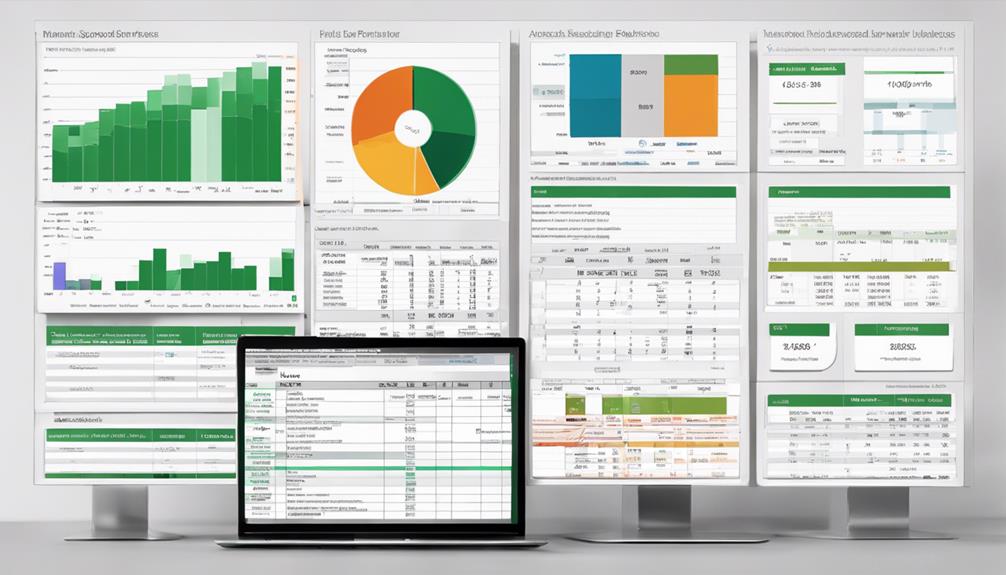Stock Mergers: Valuation and Pricing Strategies

When evaluating stock mergers, various valuation techniques are employed to determine fair terms and accurately reflect the combined entity's true value. One common method is discounted cash flow analysis, which involves projecting future cash flows and selecting an appropriate discount rate to establish intrinsic value.
Another approach involves market comparisons, where the target company's financial metrics are compared to those of its peers to assess its position in the market. Additionally, asset-based approaches like net asset value and replacement cost provide a concrete evaluation of the company's worth.
Identifying potential synergies, managing risks, and selecting the most suitable valuation method are crucial aspects of ensuring a smooth integration process during a stock merger. By incorporating these proven strategies, trust can be established among all stakeholders involved, and their interests can be aligned effectively.
Key Takeaways
- To determine the fair value of merging companies, it is essential to employ various valuation methods such as discounted cash flow analysis, comparable company analysis, and precedent transactions analysis. These methods help in assessing the financial health and potential growth of the entities involved in the merger.
- One crucial aspect of valuation is the identification and quantification of synergies that can result from the merger. Synergies can include cost savings, operational efficiencies, and revenue enhancements, which contribute to enhancing the overall value of the combined entity.
- Due diligence plays a vital role in managing risks and uncertainties during the merger process. It involves a comprehensive assessment of financial, operational, and cultural factors to ensure a smooth integration and minimize potential challenges that may arise post-merger.
- Effective communication of pricing strategies is key to aligning the interests of all stakeholders, particularly shareholders, in the merger. Building trust and transparency through clear communication can facilitate a successful merger process and create a positive environment for all parties involved.
- Adapting valuation methods and pricing strategies to changing market conditions and industry trends is crucial for the long-term success of the merger. Flexibility allows companies to navigate evolving landscapes and ensure that the merger remains sustainable and beneficial in the dynamic business environment.
Understanding Stock Merger Valuation
Understanding stock merger valuation involves assessing the value of the companies involved in a stock-based deal. Techniques like discounted cash flow analysis and market comparisons help determine the worth of the merging entities. This process is crucial for setting a fair exchange ratio between the companies' shares.
To determine the right pricing, we evaluate factors such as the financial performance, industry outlook, and competitive positioning of the merging firms. By using discounted cash flow models, we can forecast future cash flows and evaluate the intrinsic value of each company. Additionally, market comparisons are utilized to compare valuations against similar transactions or publicly traded peers.
The objective of stock merger valuation is to establish equitable terms for the shareholders of both companies. The aim is to find a fair price that accurately reflects the true value of the combined entity, ensuring a seamless and mutually advantageous integration process.
This thorough approach helps foster trust and align the interests of all stakeholders involved in the merger.
Common M&A Valuation Techniques
When it comes to mergers and acquisitions (M&A), various valuation techniques are commonly used to determine the value of target companies. These methods include the discounted cash flow (DCF) analysis, market approach, and asset approach.
The DCF model involves predicting a company's future cash flows and then discounting them at the weighted average cost of capital to determine its current value.
The market approach compares the target company to similar publicly traded firms or recent M&A deals.
Lastly, the asset approach focuses on assessing the liquidation value of a company's tangible and intangible assets.
Each valuation technique has its unique inputs, advantages, and limitations. For example, the DCF method relies on future cash flows and the discount rate, considering the long-term growth potential of the target company. While this approach is comprehensive, it's sensitive to the assumptions made during the analysis.
On the other hand, the market approach is relatively straightforward, using financial ratios and profit margins to compare the target company to its peers. However, one challenge is identifying truly comparable firms for accurate valuation.
In the context of a stock merger, where two companies combine through the exchange of shares, the valuation methods play a crucial role in determining the exchange ratio and overall value creation for shareholders. By considering factors like financial performance, growth prospects, and market conditions, M&A professionals can make informed decisions about the fair value of the entities involved.
It's common practice to utilize a mix of valuation techniques to ensure a comprehensive and accurate assessment in stock mergers.
Discounted Cash Flow Analysis

When valuing a company through discounted cash flow analysis, it's crucial to project the target firm's future cash flows accurately over a specific time frame. After determining the cash flow projections, the next step involves selecting a suitable discount rate that considers the associated risks. The accuracy of these key inputs directly impacts the estimate of the company's intrinsic value, a fundamental output of the DCF analysis. This intrinsic value serves as a vital component in the overall M&A valuation and pricing strategy.
In a stock merger, two companies combine by exchanging the shares of their stock. This type of merger allows the acquiring company to acquire the target company without using cash, making it a common strategy in the M&A landscape. Stock mergers can provide benefits such as increased market share, cost synergies, and enhanced competitiveness in the industry. However, shareholders of both companies must approve the merger, and the valuation process becomes crucial to ensure fairness and transparency in the deal.
Projecting Future Cash Flows
Discounted cash flow (DCF) analysis relies on projecting a company's future cash flows, which are then discounted to their present value to determine the firm's intrinsic worth. Accurate forecasting of revenue growth and expenses is crucial for the reliability of this valuation method, especially in the context of mergers and acquisitions (M&A).
In a stock merger, two companies combine their stocks to create a new entity. This type of merger can lead to increased market capitalization and potentially greater shareholder value. By projecting future cash flows of the merged entity, investors can assess the potential returns and risks associated with the transaction.
Analyzing a target company's historical financial performance and industry trends helps in making well-informed projections about its future cash flows. Estimating expected sales, operating costs, capital expenditures, and other key drivers of cash generation is essential in determining the investment value of the target firm in a stock merger scenario.
Robust DCF analysis is a valuable tool in M&A, enabling a thorough evaluation of the financial health and growth potential of a prospective acquisition target. By projecting future cash flows accurately, decision-makers can negotiate more effectively and ensure a successful transaction in a stock merger context.
Determining Discount Rate
Determining the discount rate is crucial in the context of Discounted Cash Flow analysis, as it directly affects the valuation of mergers and acquisitions. The discount rate represents the cost of capital and the level of risk associated with the investment, influencing the present value of future cash flows.
Factors such as the risk-free rate, market risk premium, and company-specific risk all contribute to determining the appropriate discount rate. A higher discount rate signifies higher perceived risk, leading to a lower present value of future cash flows.
To accurately assess the discount rate for stock mergers, a comprehensive understanding of the market, industry dynamics, and the specific circumstances of the target company is essential. By conducting a thorough analysis of these variables, a reliable discount rate can be derived to form the basis for valuation and pricing strategies in mergers and acquisitions.
This meticulous approach ensures that clients can make well-informed decisions, setting them up for success in the intricate realm of stock mergers.
Comparable Company Analysis
Comparable company analysis is a key tool used in valuing a target company during a stock merger by comparing it to its industry peers. This method looks at factors like market capitalization, growth potential, and operational efficiency to determine a fair valuation for the target company.
Various financial metrics, such as Price-to-Earnings (P/E) ratio, Enterprise Value (EV), and Revenue, are analyzed to evaluate the target's value compared to similar publicly traded companies. This approach offers a market-based view of the target's worth, which helps in making informed pricing decisions during the stock merger.
When assessing companies for a stock merger, it's essential to consider metrics like P/E ratio, EV/Revenue, Revenue Growth, Profit Margin, and Market Cap. By comparing these indicators across different companies in the same industry, we can gain valuable insights into the target company's valuation and its position relative to its peers.
In the context of a stock merger, understanding how a target company measures up against comparable peers can provide crucial information for determining a fair valuation and negotiating the terms of the merger. By leveraging comparable company analysis, we can make well-informed decisions that align with market trends and industry standards.
Asset-Based Valuation Approaches

When assessing the value of companies involved in stock mergers, we'll delve into three primary asset-based valuation approaches: net asset value, replacement cost valuation, and the liquidation value approach. These methods serve as a foundation for determining a company's value by closely scrutinizing its tangible and intangible assets, providing investors with crucial insights into the financial strength and potential risks of the merging firms.
Net asset value focuses on the company's total assets minus its liabilities, giving a snapshot of the company's intrinsic value.
Replacement cost valuation determines the cost of replacing the company's assets at current market prices, reflecting the minimum value needed to replicate the business.
The liquidation value approach estimates the value of the company's assets if they were sold off individually, providing a conservative assessment of the company's worth in a worst-case scenario.
Net Asset Value
Calculating a company's Net Asset Value (NAV) provides us with a conservative estimate of its worth, considering both tangible assets like buildings and equipment, and intangible assets like patents and trademarks. This asset-based valuation method is commonly used in stock mergers to determine the fair value of a target company.
NAV gives us a baseline for the company's underlying value by subtracting liabilities from total assets. This sets the stage for more robust valuation methods and helps in making informed strategic acquisition decisions.
Comparing NAV to the company's market value can reveal if the stock is over- or undervalued, guiding potential merger negotiations.
Industries that have a significant amount of tangible assets, such as manufacturing or real estate, tend to rely more heavily on asset-based valuation approaches like NAV. This method provides a solid foundation for evaluating a company's true worth during stock mergers, ensuring that the deal structure aligns with the target's intrinsic value.
Replacement Cost Valuation
While net asset value provides a conservative baseline, replacement cost valuation offers a more concrete assessment of a company's worth in stock mergers. This approach estimates the cost of replacing a company's assets at current market prices, giving a clear understanding of its intrinsic value. This method is particularly beneficial in industries such as manufacturing or real estate, where a firm's assets hold significant value and comparable market data may be limited.
In the context of stock mergers, replacement cost valuation can help acquirers determine a fair offer price based on the tangible worth of the company's assets. Unlike metrics like price-to-sales ratios, which may not fully capture the value of physical resources, this approach delves into the underlying value of assets.
By providing a robust and conservative estimate, it enhances negotiations and aids in making informed investment decisions during mergers and acquisitions.
Liquidation Value Approach
The Liquidation Value Approach provides a pragmatic and cautious evaluation of a company's worth, focusing on the potential proceeds from selling its assets individually. This method proves especially useful in distressed situations or for companies with underperforming assets, as it offers insights into the minimum value that could be realized through a quick asset sale, often at a discounted rate. Unlike market or book value assessments, the Liquidation Value Approach typically provides a more conservative estimate of a company's true worth.
This approach enables investors to gauge the value proposition of a company's free cash and intellectual property, offering a realistic understanding of the company's asset value. Such insights are crucial in merger or acquisition negotiations, where understanding the worst-case scenario regarding asset value can be instrumental in making informed decisions.
Synergies in M&A Valuation
Understanding the different types of mergers and acquisitions is crucial when it comes to valuing M&A deals. Identifying and quantifying synergies play a key role in determining the overall value that a merger or acquisition can bring. These synergies refer to the additional value that's created when two companies join forces, going beyond just the sum of their individual parts.
Cost synergies and revenue synergies are the two main types of synergies that can arise from M&A transactions. Cost synergies typically come from reducing redundant functions and optimizing operations, leading to cost savings for the combined entity. On the other hand, revenue synergies are generated from opportunities like cross-selling products and services or expanding into new markets.
In the context of a stock merger, where two companies decide to combine their stocks to form a new entity, identifying and maximizing synergies become even more critical. By leveraging the strengths of both companies and capturing synergies effectively, the new entity can enhance its overall performance and create value for shareholders.
Managing Risk and Uncertainty

When it comes to stock mergers, managing risks and uncertainties is crucial for determining the success of the transaction. Various factors such as market volatility, regulatory changes, and integration challenges can significantly impact the valuation and overall outcome of the merger.
To address these uncertainties effectively, a four-pronged approach is recommended:
- Conduct comprehensive due diligence to identify potential obstacles and evaluate their financial consequences.
- Develop detailed scenario planning to anticipate different outcomes and establish contingency plans accordingly.
- Establish clear communication channels between the merging companies to ensure alignment on pricing strategies.
- Implement robust integration management practices to facilitate a seamless transition, especially during the critical initial 100 days post-merger.
Pricing plays a vital role in the success of a stock merger, as finding the right balance between the merging parties is essential. By proactively managing risks and uncertainties through thorough planning and effective communication, the valuation and pricing strategies can be optimized, ultimately contributing to the success of the merger.
Choosing the Right Valuation Method
When evaluating the value of companies involved in stock mergers, selecting the appropriate valuation method is crucial for the success of the transaction. There are several common approaches we can utilize, each with unique advantages and considerations.
One method is the Discounted Cash Flow Analysis, which estimates a company's intrinsic value by projecting future cash flows and then discounting them to their present value. This method provides a comprehensive, forward-looking assessment of the company's worth.
Another approach is the Comparable Company Analysis, where we compare a company's financial metrics to those of similar publicly-traded firms to determine its market value. This method offers a market-based perspective on the company's valuation.
Lastly, the Precedent Transactions Analysis involves examining recent merger and acquisition deals within the same industry to estimate the target company's value. This method can provide insights into the potential worth of the company based on similar transactions.
Choosing the right valuation method depends on various factors such as the nature of the merger and the industry in which the companies operate.
Combining these different approaches can lead to more informed and accurate valuation decisions, ultimately guiding us towards successful stock mergers and acquisitions.
Frequently Asked Questions
What Are the M&A Valuation Strategies?
In determining a company's value for mergers and acquisitions, our team employs a mix of discounted cash flow, market, and asset valuation methods. We take into account expected synergies, potential integration hurdles, and the prevailing organizational culture. These customized valuation strategies enable us to offer cutting-edge M&A solutions that optimize value.
Stock mergers involve the consolidation of two companies through the exchange of shares, resulting in a combined entity with shared ownership. This type of merger allows companies to leverage their respective strengths and resources, potentially leading to increased market power and operational efficiency. Stock mergers are often pursued to achieve strategic growth objectives, expand market reach, or diversify product offerings.
What Is the Valuation Method of Merger?
We use comparable company analysis, discounted cash flow, and precedent transactions to determine the value of merger targets in stock mergers. These analytical methods, based on market data and future projections, help us establish a reasonable price that drives innovation and adds value for all parties involved.
What Are the Pricing Mechanisms for M&A?
We use sophisticated models to determine the pricing of mergers and acquisitions. By considering factors such as the liquidity of the target firm and the level of market concentration, we develop innovative strategies for pricing M&A deals. These strategies aim to maximize value for our shareholders and drive growth by strategically combining businesses.
One type of merger we often explore is a stock merger, where the acquiring company offers its own stock as a form of payment to the shareholders of the target company. This type of merger can be advantageous for both parties as it allows for the potential upside of the acquirer's stock price post-merger.
How Is Share Price Determined After Merger?
The share price after a merger is determined by analyzing the synergistic benefits of the combined entity, taking into account regulatory approvals, and addressing integration challenges. These factors play a crucial role in shaping how investors perceive the potential for innovation and growth of the new company.
There are different types of mergers and acquisitions that companies can engage in, such as horizontal mergers, vertical mergers, and conglomerate mergers. Each type brings its own set of advantages and challenges, influencing how the share price will be determined post-merger.
Stock mergers, in particular, involve the combination of two companies' stocks into one, often resulting in changes to the share price. It is essential to consider the market conditions, industry trends, and investor sentiment when determining the share price after a merger.
Conclusion
When considering a stock merger, it's important to understand the different types of mergers and acquisitions that can take place. These include horizontal mergers, where two companies in the same industry combine, vertical mergers, where companies in different stages of the supply chain merge, and conglomerate mergers, where companies in unrelated industries come together.
In the valuation of a stock merger, synergies play a crucial role in determining the overall value of the combined entity. Synergies can contribute significantly, accounting for up to 70% of the total value. When valuing a merger, it's essential to select the appropriate valuation method. Common techniques include discounted cash flow analysis, which estimates the future cash flows of the merged entity, and comparable company analysis, which compares the financial metrics of similar companies in the industry.
Successfully managing risk and uncertainty is paramount to achieving a positive outcome in a stock merger. By thoroughly assessing potential risks and uncertainties, companies can mitigate challenges and increase the likelihood of a successful integration. Understanding the types of mergers and acquisitions and implementing effective valuation methods are key steps in navigating the complexities of a stock merger.





